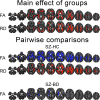White matter aberrations and age-related trajectories in patients with schizophrenia and bipolar disorder revealed by diffusion tensor imaging
- PMID: 30237410
- PMCID: PMC6147807
- DOI: 10.1038/s41598-018-32355-9
White matter aberrations and age-related trajectories in patients with schizophrenia and bipolar disorder revealed by diffusion tensor imaging
Abstract
Supported by histological and genetic evidence implicating myelin, neuroinflammation and oligodendrocyte dysfunction in schizophrenia spectrum disorders (SZ), diffusion tensor imaging (DTI) studies have consistently shown white matter (WM) abnormalities when compared to healthy controls (HC). The diagnostic specificity remains unclear, with bipolar disorders (BD) frequently conceptualized as a less severe clinical manifestation along a psychotic spectrum. Further, the age-related dynamics and possible sex differences of WM abnormalities in SZ and BD are currently understudied. Using tract-based spatial statistics (TBSS) we compared DTI-based microstructural indices between SZ (n = 128), BD (n = 61), and HC (n = 293). We tested for age-by-group and sex-by-group interactions, computed effect sizes within different age-bins and within genders. TBSS revealed global reductions in fractional anisotropy (FA) and increases in radial (RD) diffusivity in SZ compared to HC, with strongest effects in the body and splenium of the corpus callosum, and lower FA in SZ compared to BD in right inferior longitudinal fasciculus and right inferior fronto-occipital fasciculus, and no significant differences between BD and HC. The results were not strongly dependent on age or sex. Despite lack of significant group-by-age interactions, a sliding-window approach supported widespread WM involvement in SZ with most profound differences in FA from the late 20 s.
Conflict of interest statement
MSc Tønnesen, Dr Kaufmann, Dr Doan, Dr Alnæs, Dr Córdova-Palomera, Dr van der Meer, Dr Rokicki, Dr Moberget, Dr Gurholt, Dr Haukvik, Dr Ueland, Dr Lagerberg, Dr Agartz, Dr Andreassen, and Dr Westlye, report no conflicts of interest.
Figures




Similar articles
-
White matter integrity in schizophrenia and bipolar disorder: Tract- and voxel-based analyses of diffusion data from the Connectom scanner.Neuroimage Clin. 2019;21:101649. doi: 10.1016/j.nicl.2018.101649. Epub 2018 Dec 31. Neuroimage Clin. 2019. PMID: 30639179 Free PMC article.
-
A Comparative Multimodal Meta-analysis of Anisotropy and Volume Abnormalities in White Matter in People Suffering From Bipolar Disorder or Schizophrenia.Schizophr Bull. 2022 Jan 21;48(1):69-79. doi: 10.1093/schbul/sbab093. Schizophr Bull. 2022. PMID: 34374427 Free PMC article.
-
Widespread white matter tract aberrations in youth with familial risk for bipolar disorder.Psychiatry Res. 2015 May 30;232(2):184-92. doi: 10.1016/j.pscychresns.2015.02.007. Epub 2015 Feb 26. Psychiatry Res. 2015. PMID: 25779034 Free PMC article.
-
From the microscope to the magnet: Disconnection in schizophrenia and bipolar disorder.Neurosci Biobehav Rev. 2019 Mar;98:47-57. doi: 10.1016/j.neubiorev.2019.01.005. Epub 2019 Jan 7. Neurosci Biobehav Rev. 2019. PMID: 30629976 Review.
-
Shared and Distinct White Matter Alterations in Major Depression and Bipolar Disorder: A Systematic Review and Meta-Analysis.J Integr Neurosci. 2024 Sep 19;23(9):170. doi: 10.31083/j.jin2309170. J Integr Neurosci. 2024. PMID: 39344242
Cited by
-
Inefficient white matter activity in Schizophrenia evoked during intra and inter-hemispheric communication.Transl Psychiatry. 2022 Oct 16;12(1):449. doi: 10.1038/s41398-022-02200-9. Transl Psychiatry. 2022. PMID: 36244980 Free PMC article.
-
Towards an optimised processing pipeline for diffusion magnetic resonance imaging data: Effects of artefact corrections on diffusion metrics and their age associations in UK Biobank.Hum Brain Mapp. 2019 Oct 1;40(14):4146-4162. doi: 10.1002/hbm.24691. Epub 2019 Jun 7. Hum Brain Mapp. 2019. PMID: 31173439 Free PMC article.
-
White Matter Microstructure across the Psychosis Spectrum.Trends Neurosci. 2020 Jun;43(6):406-416. doi: 10.1016/j.tins.2020.03.014. Epub 2020 Apr 26. Trends Neurosci. 2020. PMID: 32349908 Free PMC article. Review.
-
Linking Psychotic-Like Experiences and Brain White Matter Microstructure in Young Women.Brain Behav. 2025 Jun;15(6):e70587. doi: 10.1002/brb3.70587. Brain Behav. 2025. PMID: 40443294 Free PMC article.
-
Adipose tissue distribution from body MRI is associated with cross-sectional and longitudinal brain age in adults.Neuroimage Clin. 2022;33:102949. doi: 10.1016/j.nicl.2022.102949. Epub 2022 Jan 27. Neuroimage Clin. 2022. PMID: 35114636 Free PMC article.
References
-
- Kaufmann Tobias, Skåtun Kristina C., Alnæs Dag, Doan Nhat Trung, Duff Eugene P., Tønnesen Siren, Roussos Evangelos, Ueland Torill, Aminoff Sofie R., Lagerberg Trine V., Agartz Ingrid, Melle Ingrid S., Smith Stephen M., Andreassen Ole A., Westlye Lars T. Disintegration of Sensorimotor Brain Networks in Schizophrenia. Schizophrenia Bulletin. 2015;41(6):1326–1335. doi: 10.1093/schbul/sbv060. - DOI - PMC - PubMed
Publication types
MeSH terms
LinkOut - more resources
Full Text Sources
Other Literature Sources
Medical
Miscellaneous

